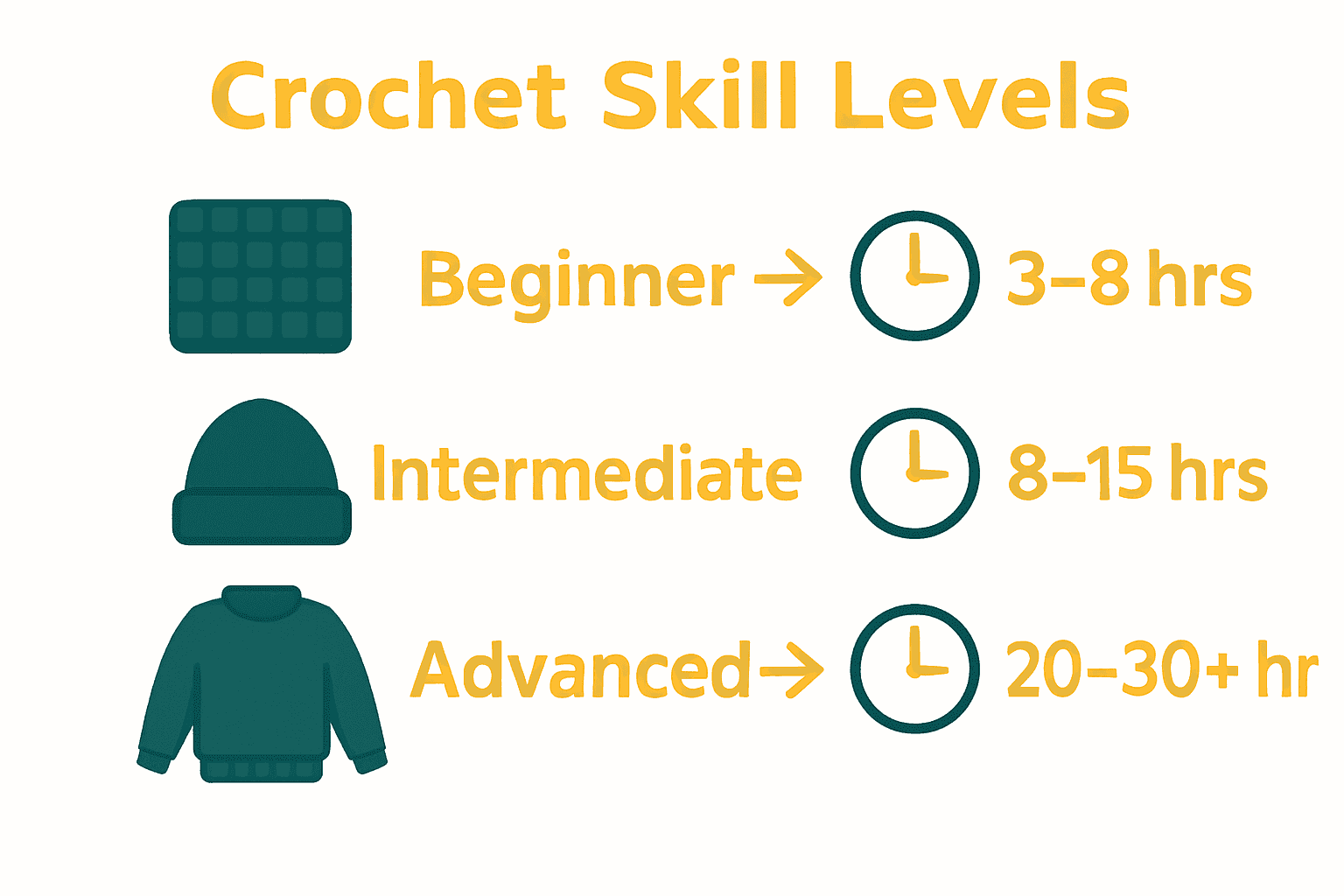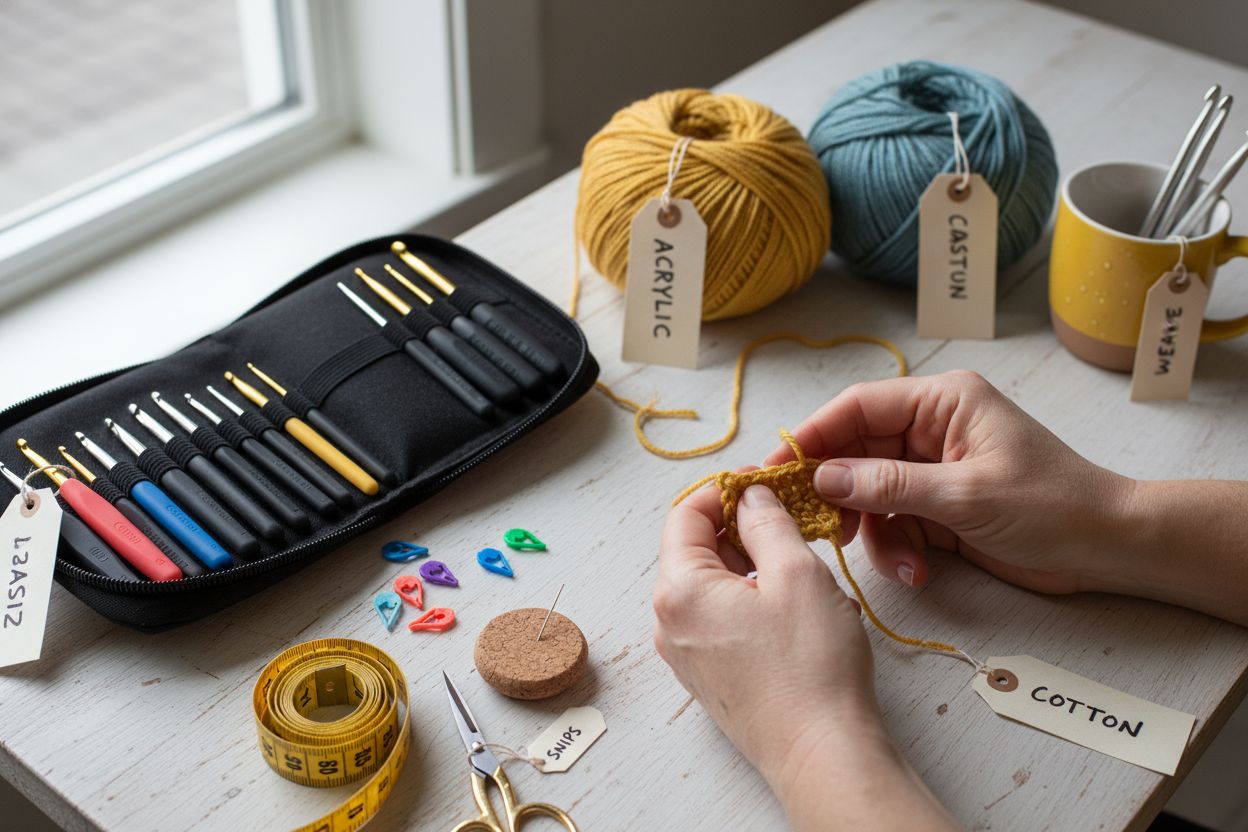
How to Select Crochet Projects for Crafting Success
Did you know that over 60 percent of beginner crochet projects end up unfinished? Many crafters give up because their first patterns are too complex or they pick materials that cause frustration. Selecting the right crochet project is more than picking a pretty pattern. The secret lies in balancing your skill level, time, and personal interests. Learn how to set yourself up for a rewarding and stress-free crafting experience from start to finish.
Quick Summary
| Key Point | Explanation |
|---|---|
| 1. Assess your skill level first | Evaluate your current crochet abilities to select appropriate projects that challenge without overwhelming you. |
| 2. Choose suitable materials | Focus on forgiving yarns like acrylic or cotton, ensuring they suit your project and skill level for a smoother experience. |
| 3. Research inspiring patterns | Find beginner-friendly patterns with clear instructions and save those that excite you for a fulfilling crafting journey. |
| 4. Match projects with available time | Align project complexity with your schedule; consider breaking larger tasks into manageable goals to maintain motivation. |
| 5. Verify project fit before starting | Check all materials, patterns, and your skill level for compatibility, ensuring a smoother and more enjoyable crafting experience. |
Table of Contents
- Step 1: Assess Your Skill Level And Crafting Goals
- Step 2: Gather Suitable Materials And Yarn
- Step 3: Research And Shortlist Inspiring Patterns
- Step 4: Match Patterns With Your Available Time
- Step 5: Verify Project Fit Before You Start
Step 1: Assess Your Skill Level and Crafting Goals
Selecting the perfect crochet project starts with an honest evaluation of your current skills and realistic crafting goals. This step helps you choose projects that will challenge you without overwhelming your abilities or available time.
Begin by reflecting on your previous crochet experiences. Are you a complete beginner who has only mastered basic stitches? Or do you have some experience creating smaller items? According to research from Magic Owl Studios, starting with small and manageable projects first builds confidence and supports skill growth.
Consider the time you can realistically dedicate to crafting. Research from Cy Crochet reveals that different projects require vastly different time commitments—a simple scarf might take 3 to 8 hours, while a sweater could demand 20 to 30 hours. Understanding these time investments helps you align your project selection with your schedule and personal commitments.
Create a simple skill progression plan for yourself:
Here’s a comparison of recommended crochet project types by skill level and estimated time:

| Skill Level | Project Examples | Estimated Time Range |
|---|---|---|
| Beginner | Washcloth Simple Scarf Basic Amigurumi |
3-8 hours |
| Intermediate | Structured Hat Small Garment |
8-15 hours |
| Advanced | Sweater Detailed Blanket |
20-30 hours or more |
- Beginners: Start with washcloths, simple scarves, or basic amigurumi
- Intermediate crafters: Move to more complex patterns like structured hats or small garments
- Advanced crocheters: Challenge yourself with intricate sweaters or detailed blankets
Pro Tip: Always choose a project that feels slightly beyond your current comfort zone—this approach ensures continuous learning without causing frustration.
By carefully assessing your skill level and setting realistic goals, you set yourself up for a rewarding crafting journey. In the next step, we will explore how to match your skills with the right project complexity and design.
Step 2: Gather Suitable Materials and Yarn
Now that you understand your skill level, it is time to gather the right materials that will set you up for crochet success. Selecting the appropriate yarn and tools can make the difference between a frustrating experience and an enjoyable crafting journey.
According to research from Handy Little Me, beginners should focus on selecting yarn fibers that are forgiving and easy to work with. Acrylic, cotton, and wool blends are excellent choices for those just starting their crochet adventure. These materials provide good stitch definition and are relatively affordable.
When choosing your yarn, pay close attention to the weight and recommended hook size printed on the label. Match this with the pattern you have selected. Avoid novelty yarns with complex textures or dark colors that can make it challenging to see your stitches clearly. Clear visibility is crucial when you are learning and practicing new techniques.

Your basic crochet toolkit should include:
- Crochet hooks in various sizes
- Scissors
- Stitch markers
- Tapestry needle for weaving in ends
- Measuring tape
Pro Tip: Purchase a small amount of yarn initially. This allows you to practice without significant investment and helps you understand how different yarns feel and work.
By carefully selecting your materials, you are laying the groundwork for a successful crochet project. In the next step, we will explore how to read and understand your chosen pattern effectively.
Step 3: Research and Shortlist Inspiring Patterns
With your skill level assessed and materials gathered, it is time to dive into the exciting world of pattern hunting. Finding the right pattern can transform your crafting experience from a simple project to a truly inspiring journey.
According to research from Secret Yarnery, focusing on beginner-friendly patterns with clear instructions is key to maintaining motivation. Look for resources like crafting blogs, Pinterest boards, and Ravelry where you can find patterns tailored to your skill level.
Research from Yarn Seasons suggests evaluating patterns through multiple lenses. Consider factors beyond just visual appeal:
- Yarn compatibility with your selected materials
- Color schemes that excite you
- Project budget requirements
- Seasonal appropriateness of the design
Start by creating a digital or physical inspiration board. Save patterns that spark joy and align with your current abilities. Mix in quick win projects alongside more complex long-term designs to keep your motivation high.
Pro Tip: Read pattern comments and reviews from other crafters. Their experiences can reveal potential challenges or offer helpful modification tips.
By carefully curating your pattern selection, you are setting the stage for a fulfilling crafting adventure.
In our next step, we will explore how to translate your chosen pattern into a successful project.
Step 4: Match Patterns with Your Available Time
Selecting a crochet project is not just about skill and inspiration—it is equally about understanding how much time you can realistically dedicate to your craft. Matching your pattern to your available time ensures you create a project that feels enjoyable rather than overwhelming.
Research from Cy Crochet provides helpful time estimates for different project types. A beginner scarf might require 8 or more hours, while an intermediate crafter could complete the same project in 3 to 4 hours. More complex projects like sweaters can demand 20 to 30 hours of dedicated crafting time.
To make informed decisions, consider these time investment strategies:
- Break larger projects into manageable weekly goals
- Choose patterns with clear time estimates
- Alternate between quick win projects and longer commitments
- Track your actual crafting speed to improve future planning
There are emerging digital tools that can help you plan more effectively. According to research from Crochify Patterns, online Crochet Time Estimators allow you to input project type, skill level, and daily available time to generate realistic completion estimates.
Pro Tip: Always add 20% extra time to your initial project estimate to account for learning curves and unexpected challenges.
By thoughtfully matching patterns to your schedule, you transform crafting from a potential source of stress into a delightful, achievable hobby. Our next step will help you prepare for a smooth project launch.
Step 5: Verify Project Fit Before You Start
Before diving headfirst into your crochet project, take a moment to ensure everything aligns perfectly with your goals and capabilities. This crucial verification step can save you hours of potential frustration and disappointment.
According to research from Magic Owl Studios, organizing your tools, yarn, and pattern together is a foundational strategy for project success. Create a dedicated workspace where you can lay out all your materials and double-check their compatibility.
Research from High Desert Yarn suggests adding buffer time to your project timeline. This means setting realistic mini deadlines and planning ahead, especially for larger pieces. Consider breaking your project into manageable milestones that feel achievable and motivating.
Your project verification checklist should include:
- Confirm yarn weight matches pattern requirements
- Check that you have all necessary tools
- Review pattern difficulty against your current skill level
- Ensure you have enough uninterrupted time to make meaningful progress
- Verify you have enough yarn to complete the entire project
Pro Tip: Make a practice swatch first. This small sample will help you confirm gauge, stitch tension, and overall project feasibility before fully committing.
By thoroughly verifying your project fit, you are setting yourself up for a smooth and enjoyable crafting experience. Our next step will guide you through the exciting process of starting your chosen project.
Take the Stress Out of Crochet Project Selection with CRAFTISS
Do you ever feel overwhelmed when trying to choose the right crochet project that matches your current skill level and materials? Many crafters struggle with finding reliable yarn, staying organized, and making sure they have the perfect tools on hand—the exact concerns discussed in the article above. Now, you can skip the second-guessing and focus on your creativity. Browse our curated Yarn collection and discover beginner-friendly options and vibrant colors tailored for every type of project.
.png)
Ready to take your next crochet idea from inspiration to completion? Set yourself up for real crafting success by pairing high-quality yarns with smart storage from our Yarn Bags collection. Visit CRAFTISS today to find all the essentials you need to make every crochet project rewarding. Start now and experience the difference for yourself.
Frequently Asked Questions
How do I assess my skill level for selecting crochet projects?
To assess your skill level, reflect on your past crochet experiences and identify the types of projects you have successfully completed. Create a list of these projects to help you determine whether you’re a beginner, intermediate, or advanced crocheter.
What are some suitable crochet projects for beginners?
Beginner crocheters should start with projects like washcloths, simple scarves, or basic amigurumi. Focus on projects that can be completed within 3 to 8 hours to build confidence and enhance your skills.
How can I choose the right yarn for my crochet project?
Select yarn fibers that are easy to work with, such as acrylic or cotton blends, especially if you’re just starting. Ensure the weight and recommended hook size matches the pattern you’ve chosen to avoid frustration during your project.
What factors should I consider when researching crochet patterns?
When researching patterns, evaluate factors such as yarn compatibility, project complexity, and your available crafting time. Create a shortlist based on these criteria to keep yourself motivated and aligned with your skill level.
How can I estimate the time needed for a crochet project?
Estimate your project time by considering the complexity and size of the item. For instance, simple projects like scarves may take 3 to 8 hours, while sweaters can require 20 to 30 hours; plan your schedule accordingly to stay on track.
What checks should I perform before starting a crochet project?
Before starting, verify that your yarn and tools match the pattern requirements and confirm your skill level aligns with the project’s difficulty. Make a practice swatch to gauge your stitch tension and ensure a successful crafting experience.


